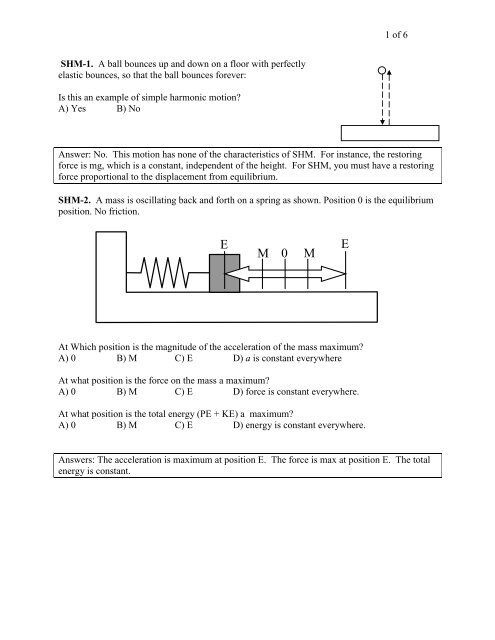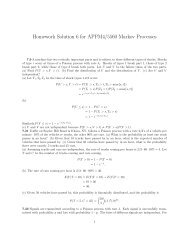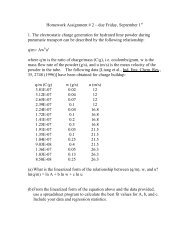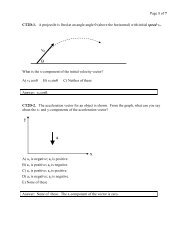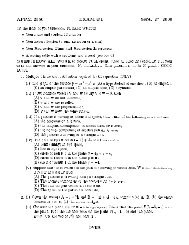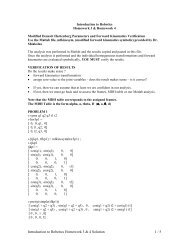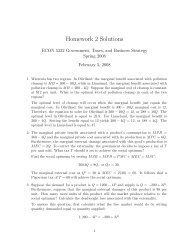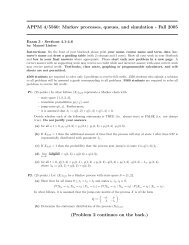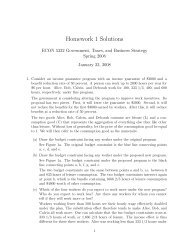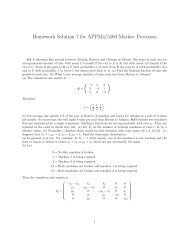Create successful ePaper yourself
Turn your PDF publications into a flip-book with our unique Google optimized e-Paper software.
1 of 6SHM-1. A ball bounces up and down on a floor with perfectlyelastic bounces, so that the ball bounces forever:Is this an example of simple harmonic motion?A) Yes B) NoAnswer: No. This motion has none of the characteristics of SHM. For instance, the restoringforce is mg, which is a constant, independent of the height. For SHM, you must have a restoringforce proportional to the displacement from equilibrium.SHM-2. A mass is oscillating back and forth on a spring as shown. Position 0 is the equilibriumposition. No friction.EM0 MEAt Which position is the magnitude of the acceleration of the mass maximum?A) 0 B) M C) E D) a is constant everywhereAt what position is the force on the mass a maximum?A) 0 B) M C) E D) force is constant everywhere.At what position is the total energy (PE + KE) a maximum?A) 0 B) M C) E D) energy is constant everywhere.Answers: The acceleration is maximum at position E. The force is max at position E. The totalenergy is constant.
2 of 6SHM-3. A stiff spring and a floppy spring have potential energy diagrams shown below.Which is the stiff spring? A) PINK B) YELLOWPEPExxPinkYellowTwo masses are identical. One is attached to a stiff spring; the other to a floppy spring. Both arepositioned at x = 0 and given the same initial speeds. Which spring produces the largestamplitude motion? A) The stiff spring B) The floppy spring C) Same!Now the identical masses on the two different springs are pulled to the side and released fromrest with the same initial amplitude. Which spring produces the largest maximum speed of itsmass? A) The stiff spring B The floppy spring C) Same!If the spring constant is increased, but the total energy of a mass/spring system is kept constant,what happens to the amplitude A of the motion?A) A increases B) A decreases C) A stays constantAnswers: The Yellow spring his the stiff one. The floppy spring will have the larger amplitudemotion, for a given initial speed of the mass starting at the origin. The stiff spring will have thelargest max speed, for a given initial amplitude, starting at rest. If the spring constant isincreased, but the total energy KE+PE is kept constant, then the amplitude decreases.
3 of 6SHM-4. The position of a mass on a spring as a function of time is shown below. When themass is at point P on the graph, ..xPtA) The velocity v > 0 B) v < 0 C) v = 0A) The acceleration a > 0 B) a < 0 C) a = 0Answers: The velocity is positive and the acceleration is negative.SHM-5. Consider a variable x = x() and the differential equationHere are some proposed solutions of this equation:I. x sin II. x cos III. xe How many of these are actually solutions:A) all of them B) None of them C) 1 of themD) 2 of them.Answer: 2 of them: I and II are solutions. III is not a solution.2dxd2x.SHM-6. A mass on a spring oscillates with a certain amplitude A and a certain period T. If themass m is doubled, the spring constant k of the spring is doubled, and the amplitude of motion Ais doubled, THEN the period T... A) increases B) decreases C) stays the same.Answer: The period T stays the same.
SHM-7. The solid curve is a graph of x( t) Acos( t)x( t) Acos( t )positive or negative?Ax4 of 6 . The dotted curve is a graph of where is a phase constant whose magnitude is less than /2. Is t-AA: Positive B: Negative.[Hint: cos() reaches a maximum when =0, that is, at cos(0).]Answer: Negative.SHM-8. Consider the function f() = cos()cosWhat is for one period?A) B) 1 C) 2 D) 2 E) TAnswer: 2
5 of 6SHM-9. A mass on a spring oscillates with a certain amplitude A and a certain period T. If themass m is doubled, the spring constant k of the spring is doubled, and the amplitude of motion Ais doubled, THEN the period T...A) increases B) decreases C) stays the same.Answer: stays the sameSHM-10. What is the sign of cos(225 o )? Sign of sin(225 o )?A) cos(225 o ) = (+) , sin(225 o ) = (–)B) cos(225 o ) = (–) , sin(225 o ) = (+)C) cos(225 o ) = (+) , sin(225 o ) = (+)D) cos(225 o ) = (–) , sin(225 o ) = (–)E) None of these. One of them is zero.Answer: cos(225 o ) = (–) , sin(225 o ) = (–)370 o = (3/2). What is cos[(3/2)] and what is sin[(3/2)] ?A) cos[(3/2)] = 1, sin[(3/2)] = 0B) cos[(3/2)] = 0, sin[(3/2)] = 1C) cos[(3/2)] = 1, sin[(3/2)] = 1D) cos[(3/2)] = 0, sin[(3/2)] = 0E) None of theseAnswer: None of these: cos[(3/2)] = 0, sin[(3/2)] = 1SHM-11.A kid is swinging on a swing with a period T. A second kid climbs on with the first, doublingthe weight on the swing. The period of the swing is now...A) the same, T B) 2T C) 2TD) none of these.Answer: the same T. The period of a simple pendulum depends only on g and the length of thependulum L.
6 of 6SHM-12.You take your grandfather clock (a pendulum clock) to the Moon. On the Moon, does the clockkeep good time, or run slow or fast?A) keeps good time B) runs slow C) runs fastAnswer: runs slowSHM-13. The force on a pendulum mass along the direction of motion is mgsin.For small , mgsinmg, and the period is independentof amplitude. For larger amplitude motion, the periodA: increasesB: decreasesC: remains constantHint: does sin get bigger or smaller than as increases.mgsinmgAnswer: For larger amplitude motion, the period increases


